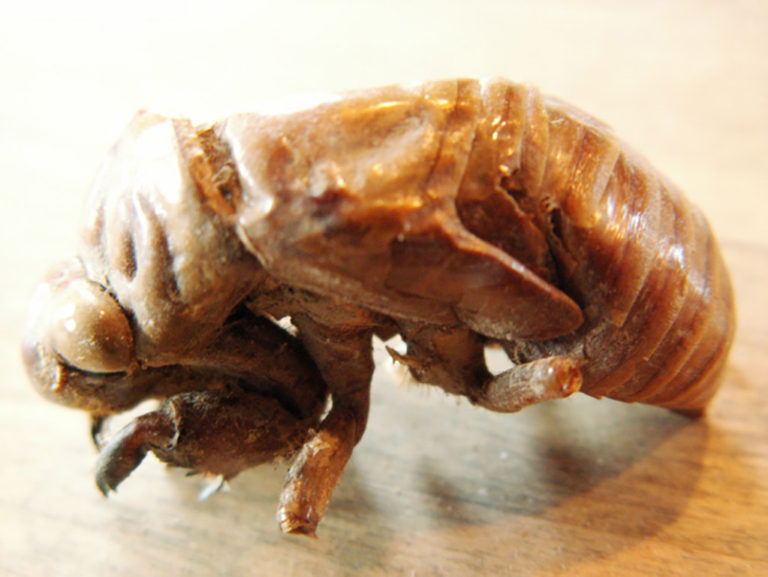After 17 years, Cicadas are emerging with a synchronous racket. These prehistoric insects live for only 2 weeks and for me, it’s the sound of summer.
In Chinese medicine, we use cicada molting as medicine. Chán tuì in Chinese, is special in that it’s one of the few medicinals that treats both internal and external wind. It’s light and floating nature directs its actions up and out to dissapte wind.
Chan Tui
chán tuì 蝉蜕
Periostracum Cicadae cicada moulting
Flavor and temperature:Sweet, Salty, Slightly Cool
Channels: Liver and Lung Channels
Chan tui’s main sphere of action is eliminating wind. From the Lungs; external pathogens and from the Liver- internal wind stirring.
We use it in formulas for a range of internal and external conditions; to ease a sore throat; to vent rashes and alleviate itching. It’s used often in ophthalmology as well as to stop spasms. It’s even used in pediatrics for night crying. (and it doesn’t taste bad!)
There were several diseases that I wrote about in my textbook TCM Case Studies: Eye, Ear, Nose and Throat Disorders, that include cicadas and I thought I’d share a cases study of herpes simplex keratitis, which is one of the leading causes of blindness worldwide.
Note: In Western disease will have several pattern presenations: This case represents only one way we might assess and treat herpes simplex keratitis.
Chan Tui eliminates “Screens’ from the eye: meaning it treats superficial visual obstruction. To illustrate how the medicinal might be used in ophthalmology, Here’s a case study from my book on the treatment of Herpes Simplex Keratitis, a highly infectious disease that is a leading cause of blindness.
Note: this is just one of several patterns, which are discussed in detail in the book.
CASE STUDY Herpes Simplex Keratitis.
Female, age 27. Initial Visit: July 25, 2006
Chief Complaint: Recurrent dryness, pain, and declined vision in the right eye for a year, aggravated for five days with photophobia and tearing.
History: One year ago, the patient suffered from dryness, pain, and declining vision in her right eye. She was diagnosed with herpes simplex keratitis. Her symptoms subsided after being treated with antiviral eye drops. Afterward, this disease would recur when she was tired or had a cold. Five days ago, she caught a cold and suffered again from dryness, pain, photophobia, tearing, along with a significant decline of vision in her right eye. She was unsuccessfully treated with acyclovir eye drops, and her condition worsened.
Signs and Symptoms: Dryness, pain, photophobia, tearing, and blurred vision in her right eye, with a slightly swollen eyelid, turbid hyperemia of the conjunctiva, star-like nebulae on the cornea, nasal congestion, a sore throat, a red tongue with a thin yellow coating, a rapid pulse.
History: Herpes simplex keratitis for one year.
Ophthalmologic Examination: Right eye vision 0.3, left eye vision 1.2. Slightly swollen eyelid of the right eye, mixed conjunctival hyperemia, a punctate opacity below the cornea center with fluorescein staining (+), clear aqueous humor, and sensitive pupillary light reflex.
Pattern Differentiation
The cornea is associated with the wind wheel and belongs to the liver. Externally contracted wind-heat follows the trajectory of the liver channel and invades the cornea, resulting in a nebula. The nebula obstructs the path of light, leading to blurred vision. Wind-heat invades the eyes and causes blood stagnation in the collaterals of the eye, leading to turbid hyperemia of the conjunctiva, dryness, pain, tearing, and photophobia. Wind-heat transforms into fire and attacks the upper body, resulting in nasal congestion and sore throat. The red tongue with a thin yellow coating and a floating rapid pulse are all signs of wind-heat.
The disease location is in the cornea, and the pattern is differentiated as wind-heat invading the eye. It is an excessive pattern.
Diagnosis
WM diagnosis: Herpes simplex keratitis (right eye)
TCM diagnosis: Clustered star nebula due to wind-heat invading the eye
Clinical Treatment
The clustered star nebula, redness, and tearing were indications of wind-heat. Therefore, the treatment should focus on scattering wind and clearing heat, assisted by nebula-abating medicinals. Antiviral agents may be applied to the affected eye.
Principles: Scatter wind, clear heat, remove nebula, and improve vision.
Formula: Modified Yín Qiào Săn (Lonicera and Forsythia Powder)
[银翘散加减]
金银花 | jīn yín huā | 15 g | Flos Lonicerae Japonicae |
连翘 | lián qiào | 12 g | Fructus Forsythiae |
薄荷 | bò he | 10 g | Herba Menthae (added later) |
荆芥 | jīng jiè | 10 g | Herba Schizonepetae |
牛蒡子 | niú bàng zĭ | 10 g | Fructus Arctii |
大青叶 | dà qīng yè | 10g | Folium Isatidis |
赤芍 | chì sháo | 10 g | Radix Paeoniae Rubra |
紫草 | zi căo | 10g | Radix Arnebiae |
木贼草 | mù zéi căo | 10g | Herba Equiseti Hiemalis |
蝉蜕 | chán tuì | 10g | Periostracum Cicadae |
淡竹叶 | dàn zhú yè | 6 g | Herba Lophatheri |
[Formula Analysis]
Jīng jiè, bò he, and niú bàng zi scatter wind and expel pathogens.
Jīn yín huā, lián qiào, dà qīng yè and dàn zhú yè clear heat, resolve toxins and vent the pathogens.
Chì sháo and zi căo cool the blood and remove the redness.
Mù zéi căo and chán tuì dispel wind, clear heat and remove nebula.
Ready to use Chan Tui in a formula? Order here
Cara Frank, L.OM., is an acupuncturist, herbalist, businesswoman, and author. She was raised in a health food store in Brooklyn, NY. When she was 8, she cartwheeled 5 miles from Greenwich Village through Soho and Chinatown and across the Brooklyn Bridge. For nearly 40 years, Cara has had the same crazy passion for Chinese medicine. At 17, she had her first acupuncture treatment. At 20, she enrolled in acupuncture school. In 1998 she went to China to study, where she fell deeply in love with East Asian Herbs. Since then, she has devoted her life to studying and teaching the topic.
Cara is the founder of Six Fishes Healing Arts in Philadelphia, where she maintains a busy acupuncture practice and acts as the head fish of a warm and lively office. She is the president of China Herb Company and has recently launched and practitioners trained in Chinese Herbal Medicine, looking to improve their practices are welcome to join.
. Cara is the author of TCM Case Studies: Eye Ear Nose and Throat Disorders. You can read her full bio or schedule an appointment.





